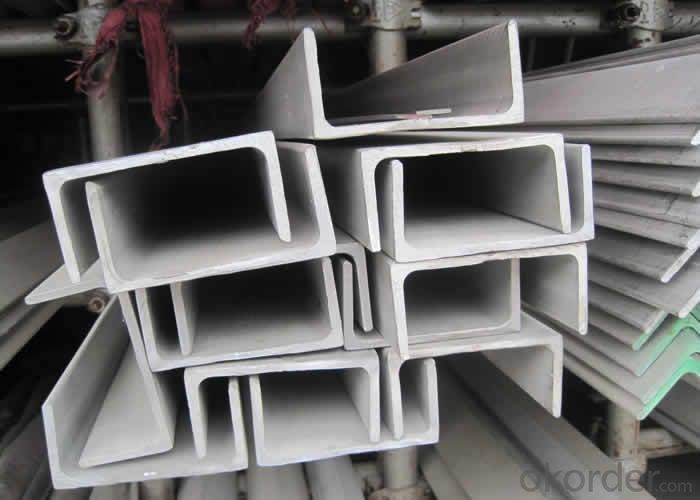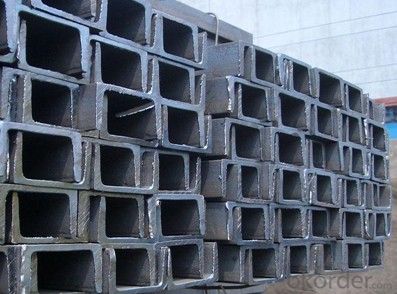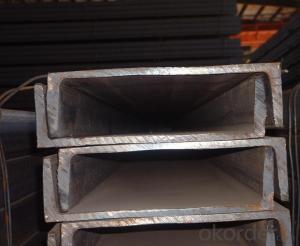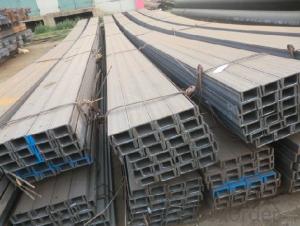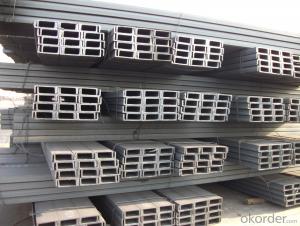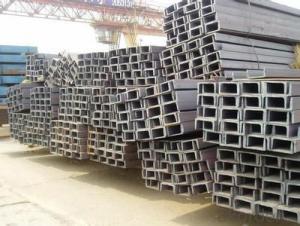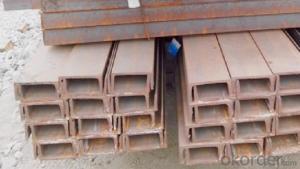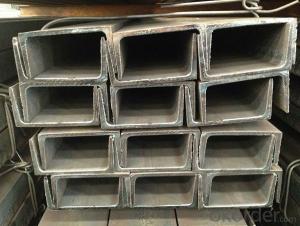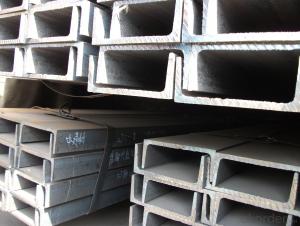Hot Rolled Channel Steel Module of GB JIS Standard
- Loading Port:
- Tianjin
- Payment Terms:
- TT OR LC
- Min Order Qty:
- 3000 PCS
- Supply Capability:
- 42000 PCS/month
OKorder Service Pledge
OKorder Financial Service
You Might Also Like
JIS Standard Hot Rolled Channel Steel Details
Standard: | BS,GB,JIS | Dimensions: | 50*25MM-250*90MM | Grade: | Q235 |
Color: | black | Perforated Or Not: | Not Perforated | Model Number: | 50*25MM-250*90MM |
Shape: | CHANNEL | Application: | SHIPPING,BUILDNG |
Packaging & Delivery
Packaging Detail: | MIill's export standard packing in bundles with wire rod as customer's requirement |
Delivery Detail: | about 10-30 days after reciving the L/C |
JIS Standard Hot Rolled Channel Steel Specification
JIS STANDARD CHANNEL | |||||||
Size (mm) | T (mm) | b (mm) | Theoretical Weight (kg/m) | Size (mm) | T (mm) | b (mm) | Theoretical Weight (kg/m) |
50*25 | 3.00~5.00 | 6 | 2.37~3.46 | 125*65 | 5.3 | 6.8 | 12.17 |
75*40 | 3.8 | 7 | 5.3 | 125*65 | 5.5 | 8 | 12.91 |
75*40 | 4 | 7 | 5.6 | 125*65 | 6 | 8 | 13.4 |
75*40 | 4.5 | 7 | 5.85 | 150*75 | 5.5 | 7.3 | 14.66 |
75*40 | 5 | 7 | 6.92 | 150*75 | 5.7 | 10 | 16.71 |
100*50 | 3.8 | 6 | 7.3 | 150*75 | 6 | 10 | 17.9 |
100*50 | 4.2 | 6 | 8.03 | 150*75 | 6.5 | 10 | 18.6 |
100*50 | 4.5 | 7.5 | 8.97 | 150*75 | 9 | 12.5 | 24 |
100*50 | 5 | 7.5 | 9.36 | 200*80 | 7.5 | 11. | 24.6 |
125*65 | 5.2 | 6.8 | 11.66 | 250*90 | 9 | 13 | 34.6 |
Length=6-12meters SS400 or Q235 | |||||||
JIS Standard Hot Rolled Channel Steel Pictures
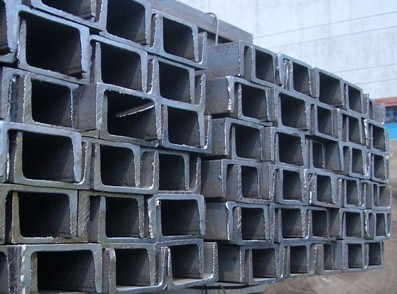
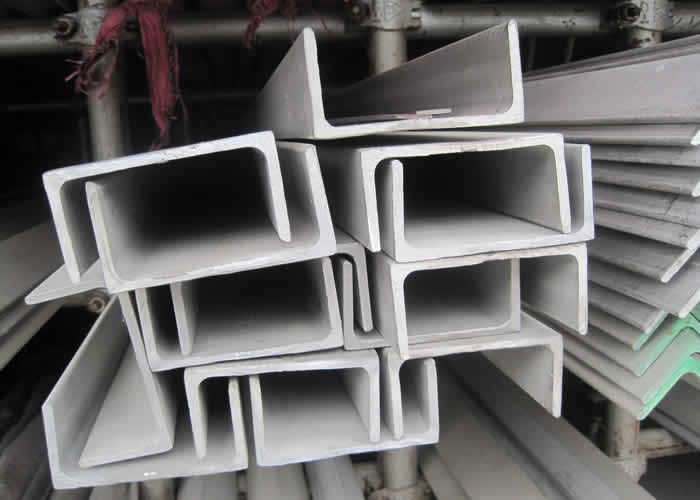
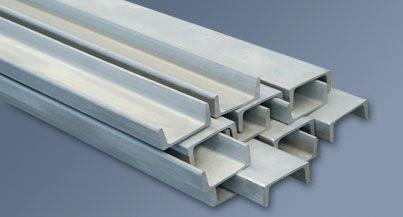

- Q: What are the different methods for surface preparation of steel channels?
- There are several different methods for surface preparation of steel channels, each with its own advantages and suitability for specific applications. Some of the common methods include: 1. Mechanical Cleaning: This method involves using abrasives such as sandpaper, wire brushes, or grinding wheels to physically remove any loose rust, scale, or old coatings from the surface of the steel channels. Mechanical cleaning is typically done manually or with the help of power tools and is a cost-effective way to prepare the surface. 2. Chemical Cleaning: This method involves using chemicals to dissolve or loosen contaminants on the steel channel's surface. Acid-based cleaners are commonly used, such as phosphoric acid or citric acid, which can effectively remove rust and other surface contaminants. Chemical cleaning is often used for removing heavy rust or scale buildup. 3. Power Tool Cleaning: This method involves using power tools like power sanders, rotary hammers, or wire brushes to remove loose rust, scale, or old paint from the steel channel's surface. Power tool cleaning is usually faster and more efficient than manual methods, making it ideal for larger surfaces or areas with heavy contamination. 4. High-Pressure Water Cleaning: This method involves using high-pressure water jets to remove loose rust, scale, or old coatings from the steel channel's surface. High-pressure water cleaning is effective for removing surface contaminants without causing damage to the metal. It is commonly used in industrial settings where large areas need to be cleaned quickly and efficiently. 5. Abrasive Blasting: This method involves using compressed air or water to propel abrasive materials, such as sand, grit, or steel shot, onto the steel channel's surface. Abrasive blasting is highly effective in removing rust, scale, and old coatings, leaving a clean and profiled surface ready for further treatment or coating. It is commonly used in industries where a high-quality surface finish is required. It is important to select the appropriate method for surface preparation based on the condition of the steel channel, the desired surface finish, and the specific requirements of the application. Proper surface preparation is crucial for ensuring good adhesion of coatings and extending the lifespan of the steel channels.
- Q: Can steel channels be used in infrastructure projects?
- Yes, steel channels can be used in infrastructure projects. Steel channels are commonly utilized to provide structural support and reinforcement in various infrastructure applications such as bridges, buildings, highways, and railways. Their high strength and durability make them suitable for withstanding heavy loads and adverse environmental conditions, ensuring the stability and longevity of the infrastructure.
- Q: Can steel channels be used for creating support structures for HVAC systems?
- Yes, steel channels can be used for creating support structures for HVAC systems. Steel channels are commonly used in the construction industry for their strength and durability. They provide a stable and reliable framework to support the weight and components of HVAC systems. Steel channels can be easily customized and fabricated to meet the specific requirements of the HVAC system, ensuring a secure and efficient support structure. Additionally, steel channels have high load-bearing capacity, allowing them to withstand the weight of the HVAC system and any additional loads that may be applied. Overall, steel channels are a suitable choice for creating support structures for HVAC systems due to their strength, durability, and customization capabilities.
- Q: Are steel channels suitable for residential construction?
- Yes, steel channels can be suitable for residential construction. Steel channels, also known as C-channels or U-channels, are often used in construction for their strength and durability. They are commonly used as structural components in framing systems, providing support and stability to the building. Steel channels have several advantages that make them suitable for residential construction. Firstly, they have a high strength-to-weight ratio, meaning they can support heavy loads while being relatively lightweight. This makes them ideal for constructing floors, walls, and roofs in residential buildings. Furthermore, steel channels are highly resistant to fire, termites, and other pests, which can be concerns in residential areas. They do not warp, rot, or decay like other materials such as wood, ensuring a longer lifespan for the building. In addition, steel channels can be easily fabricated and installed, which helps streamline the construction process. They can be cut to the desired length and shape, allowing for flexibility in design. Moreover, they can be easily connected and welded, ensuring strong connections and reducing the risk of structural failures. Lastly, steel channels are cost-effective in the long run. Although they may have a higher initial cost compared to some other materials, their durability and low maintenance requirements result in reduced repair and replacement costs over time. However, it is important to consider the specific requirements and regulations of the residential construction project, as well as consulting with professionals, such as architects and engineers, to ensure that steel channels are suitable for the specific application.
- Q: Can steel channels be used for overhead garage doors?
- Yes, steel channels can be used for overhead garage doors. Steel channels provide strong and durable support for the weight of the garage door. They are often used as the vertical tracks for the door, guiding the door as it opens and closes. Steel channels are known for their strength and resistance to bending or warping, making them a reliable choice for overhead garage doors. Additionally, steel channels can be customized to fit the specific dimensions of the garage door, ensuring a proper and secure installation.
- Q: Can steel channels be used for racking and shelving systems?
- Racking and shelving systems can indeed utilize steel channels. The strength and durability of steel channels make them a common choice in the construction of industrial storage systems. These channels offer a strong framework to support heavy loads and can be easily tailored to fit the specific dimensions and requirements of a racking or shelving system. Moreover, steel channels demonstrate impressive resistance to corrosion and can withstand harsh environmental conditions, ensuring their suitability for long-term usage. Furthermore, their modular design allows for convenient installation and reconfiguration, providing flexibility for future expansion or modification of the storage system. All in all, steel channels are a dependable and effective option for racking and shelving systems in diverse industrial and commercial environments.
- Q: What are the different types of steel channel profiles?
- A variety of steel channel profiles exist, each specifically designed for different applications and structural needs. Some commonly used types include: 1. C Channel: A popular steel channel profile with a cross-section in the shape of the letter "C". It is frequently utilized in construction and engineering projects as a structural support or frame for various applications. 2. U Channel: Also referred to as a U-shaped channel, this type possesses a similar cross-section to the letter "U". It finds common use in the construction, manufacturing, and automotive industries for applications such as framing, bracing, and support. 3. Hat Channel: Hat channels are distinguishable by their hat-like shape, featuring a flat bottom and two vertical sides. They are frequently employed in construction for applications like ceiling and wall framing, as well as in the automotive industry to reinforce structural components. 4. Box Channel: Box channels, as the name suggests, possess a rectangular or square cross-section. They are commonly found in construction, manufacturing, and engineering projects requiring strength and rigidity. 5. Z Channel: Z channels boast a Z-shaped cross-section, with two flanges on opposite sides and a center web connecting them. They find widespread use in construction, particularly in roofing and cladding systems, for applications such as framing, support, and bracing. 6. Lipped Channel: Lipped channels, also known as lip channels or lip sections, have an additional flange or lip along one side of the channel. This added feature provides extra strength and rigidity, making it suitable for applications like shelving, racking, and structural support. These examples represent only a fraction of the available steel channel profiles. The choice of profile depends on project-specific requirements, including load-bearing capacity, structural stability, and overall design considerations.
- Q: What are the different methods for transporting and handling steel channels?
- Various methods exist for transporting and handling steel channels, which depend on the specific requirements and logistics of the situation. Some commonly employed methods include: 1. Utilizing cranes: Cranes equipped with hooks or lifting magnets can transport and elevate steel channels. This approach is particularly suitable for heavy steel channels or large-scale projects. 2. Implementing forklifts: Forklifts with specialized attachments can transport steel channels within a facility or construction site. This method is ideal for smaller and lighter steel channels, enabling precise movement and placement. 3. Employing conveyor systems: In manufacturing settings, conveyor systems can transport steel channels between different processes. This method enhances efficiency and reduces the need for manual handling. 4. Utilizing flatbed trucks: Steel channels can be loaded onto flatbed trucks for long-distance transportation. Straps or chains are used to secure the channels and prevent movement during transit. 5. Employing palletizing: Steel channels can be stacked and secured on pallets to facilitate handling and transportation. This method is commonly used when shipping smaller quantities of steel channels or storing them in a warehouse. 6. Utilizing rollers or skids: For short distances within a facility or construction site, steel channels can be moved along rollers or skids. This method allows for easy movement and positioning of the channels. 7. Opting for rail transportation: When transporting larger quantities or over longer distances, steel channels can be transported via rail. Specialized rail cars or containers are used to securely transport the channels. It is crucial to consider the size, weight, and fragility of the steel channels when determining the appropriate method for transportation and handling. Strict adherence to safety measures is necessary to prevent accidents, and specific equipment may be required depending on the chosen method.
- Q: What are the different methods of surface preparation for steel channels?
- There are several methods of surface preparation for steel channels, each serving a specific purpose and achieving different results. Some of the most commonly used methods include: 1. Abrasive blasting: This method involves using high-pressure air or water to propel abrasive particles onto the surface of the steel channels. It effectively removes rust, scale, and other contaminants, leaving a clean and roughened surface ready for further treatment or coating. 2. Chemical cleaning: This method involves using chemicals to remove surface contaminants and oxides from the steel channels. Acid pickling is a common chemical cleaning process, where the channels are immersed in an acid bath to dissolve rust and scale. Alkaline cleaning is another method that uses alkaline solutions to remove organic contaminants. 3. Mechanical cleaning: This method involves using mechanical tools such as wire brushes, scrapers, or sandpaper to physically remove contaminants from the surface of the steel channels. It is often used for smaller areas or localized cleaning requirements. 4. Power tool cleaning: This method involves using power tools such as grinders, sanders, or wire brushes to mechanically clean the surface of the steel channels. It is effective for removing heavy rust, mill scale, and coatings. 5. Solvent cleaning: This method involves using solvents to dissolve and remove contaminants from the surface of the steel channels. It is typically used for light cleaning and degreasing purposes. 6. Water jetting: This method involves using high-pressure water jets to clean the surface of the steel channels. It can effectively remove loose rust, paint, and other debris. It is important to select the appropriate method of surface preparation based on the specific requirements of the steel channels, such as the extent of surface contamination, the desired level of cleanliness, and the type of coating or treatment to be applied. Following the appropriate surface preparation process ensures better adhesion of coatings, improved corrosion resistance, and enhanced overall performance of the steel channels.
- Q: To use channel steel as a platform, span 10m, leave above. Who can teach me to do force analysis, about how much channel (preferably 10#), how much weight, stability?. Authoritative reference materials should be provided. Because the platform is high, do not have an accident.
- The I-beam (safety) covered Daixinban or pine board, if it is to pay attention to the quantity of cement pouring cement mortar ratio and steel enough.
Send your message to us
Hot Rolled Channel Steel Module of GB JIS Standard
- Loading Port:
- Tianjin
- Payment Terms:
- TT OR LC
- Min Order Qty:
- 3000 PCS
- Supply Capability:
- 42000 PCS/month
OKorder Service Pledge
OKorder Financial Service
Similar products
Hot products
Hot Searches
Related keywords






